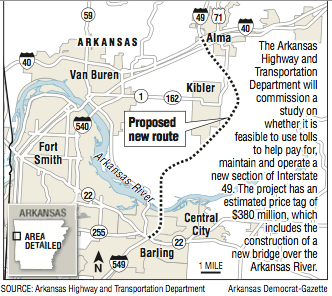The Arkansas Highway and Transportation Department is commissioning a study on the feasibility of not only using tolls to help build a new section of Interstate 49 in western Arkansas, but also to have someone else operate and maintain the tollway.
The Arkansas Highway Commission last week approved an order to solicit consultants to study using tolls and a public-private partnership to complete a 13-mile section of I-49 from Interstate 40, where I-49 ends now, south to Arkansas 22 in Barling.
If built as envisioned, it would be the first example of a public-private partnership on a roadway project in Arkansas, state highway officials said.
"The thought, if the money part works out, is that a private entity would design, build, operate and maintain the facility until it is paid for and can become a 'free' route," Scott Bennett, the department director, said last week. "Many times, with facilities such as this, there is a shortfall between the revenue generated from tolls and what is needed to build the facility.
"From this standpoint, it could actually be a design-build-finance-operate-maintain project. Part of the study should also evaluate the costs and benefits of operations and maintenance by a third party versus operations and maintenance by the department."
Last year, the department completed a 6-mile segment of Future I-49, called Arkansas 549, from Arkansas 22 and Arkansas 59 south to U.S. 71 at a cost of $130 million.
Building the new segment would fill in the gap between Arkansas 549 and I-40, providing a continuous interstate from U.S. 71 south of Fort Smith to U.S. 71 in Bentonville, state highway officials said.
The department is already using a more limited design-build method on the Interstate 30 corridor project, which will make a series of improvements to the 6.7-mile corridor through downtown Little Rock and North Little Rock, including replacing the I-30 bridge over the Arkansas River. The agency has identified $631.7 million in funding for what it calls 30 Crossing.
Design-build is a method that allows design teams and contractors to collaborate to engineer and construct projects. Proponents say it can be quicker and less expensive than the way projects are usually built, which is to design the project first and then award the construction contract to the lowest bidder.
Throwing in the possibility of tolls and a private operator to manage and maintain the tollway reflects the increasingly high cost of construction, an amount that far outstrips the financial capacity of the department.
That is particularly true on long-sought routes such as I-49, which is a north-south corridor between Kansas City, Mo., and Shreveport.
More than $1.2 billion has been spent on improvements in the Arkansas stretch of the highway, primarily north from Alma and south from Texarkana. Portions of the route have been built at new locations, but in some areas I-49 will replace, or has replaced, U.S. 71.
The biggest segment in Arkansas that's yet to be built lies between De Queen and Alma, a distance of 140 miles. It carries an estimated price tag of $2.9 billion.
The estimated price tag of the 13.7-mile segment between Barling and Alma is $380 million. The estimate includes $110 million for a new bridge over the Arkansas River.
The bridge cannot be built without connecting I-49 between Alma and Barling.
"You've got to connect the bridge on either side to make it usable," Bennett told the commission last week.
Bennett briefed local leaders about a month ago on the possibility of looking at tolls to build the new segment.
Tim Allen, president and chief executive officer of the Fort Smith Regional Chamber of Commerce, said the segment is too important for the region not to study the toll option.
"We have I-49 that is 99 percent complete from I-40 to Canada," he said in an interview. "Then we have this gap between I-40 and Fort Smith. Connecting that dot is important to our manufacturing base. We have the largest manufacturing base in Arkansas."
Completing the segment would not only help attract manufacturing jobs, but also retain the manufacturing jobs the region already has, Allen said.
"And yes, it is safe to write that this would be the first project of this particular scope that we have undertaken," he said.
The department has set aside $10.1 million for development of the segment project. But the study is a fairly exhaustive one.
The consultant will have to reassess the environmental impact statement for the project because it is outdated. The Federal Highway Administration approved it in 1997.
The consultant also will develop a "conceptual and preliminary design for more accurate cost estimating ... explore tolling as a feasible funding option and ... determine if the project is a candidate for the design/build/maintain project delivery method," state highway officials said.
From the time it takes to hire the consultant to completion of all aspects of the study, it could take two years, Bennett said.
"We need some design to know actually how much it is going to cost," Bennett said. "And this is one from the standpoint of public-private partnerships. You have tolling and the possibility of having ... design build-finance-operate-maintain. This could be a possibility.
"But we won't know unless we have the numbers, so what we're saying is we'll carve out a little of that $10 million for the tolling study so we'll know whether it's viable as a public-private partnership. A lot of that will tell us whether it's viable as a design-build project also."
Metro on 09/19/2016
